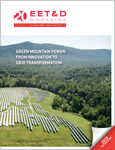Energy storage technologies are fundamental if the decarbonisation and the transition to a new energy mix are to succeed. Two different technologies offer a feasible solution for the required demand in energy storage capacity: Pumped hydropower (or heat) electrical storage (PHES) and battery storage. Whereas the former is a well-known and established technology, the latter is new but developing rapidly. These two technologies are very different and have their limitations.
According to Bloomberg New Energy Finance (BNEF), the global energy storage market will double six times between now and 2030. This equates to a start point of 5 GWh in 2016, to 300 GWh by 2030, with a total of US$103 billion invested in energy over that period. It is estimated that 70 percent of this capacity will be distributed across eight countries: the U.S., China, Japan, India, Germany, U.K., Australia and South Korea.
This trend is similar to the market expansion that solar energy experienced between 2000 and 2015, when the market share of solar PV generation doubled seven times.
It is anticipated that this growth will be driven not only by the progressive decommissioning of fossil fuels but, most importantly, by a rising need to successfully manage the production risks associated with a renewable-powered grid. Hence, this article aims to provide a comprehensive overview of the new energy storage paradigm.
Techno-Economic Considerations
The costs of lithium ion batteries are reducing at a significant rate, from US$1,200/kWh in 2012 to US$700/kWh in 2017. BNEF predicts that the cost will further plummet from US$700/kWh in 2016 to US$300/kWh in 2030. This significant fall in prices will favour investments in battery store and the mass production of batteries for a wide range of applications.
On the other hand, PHES is a very inexpensive technology, as it costs circa US$200/kWh to US$250/kWh1, making it a very cost competitive option compared to battery storage technologies2.
In addition, the capital costs for grid-scale solutions for both technologies also differ; for PHES the capital costs range from US$1.5 million to US$2.5 million per MW of capacity installed; whereas grid-scale battery solutions are estimated to be approximately US$3.5 million per MW installed3. The ability of PHES to level demand and excess power allows plants to operate at the maximum efficiency as required, thus creating a better return on investment.
Regarding life-cycle costs, lithium ion batteries have to be replaced between every 10 to 15 years, depending on their usage patterns and number of usage cycles. Therefore, a battery storage facility will need to be replaced at least six times during the potential 100-year life of a pumped storage project4. According to the BNEF, lithium-Ion batteries are expected to decrease in price to US$120/kWh in 2025, which means that whole life cycle costs, including Operation & Maintenance, could fall in the range of US$200/kWh to US$300/kWh by 2025, which will put them in a very good economic position against PHES5.
Future Prospects
Energy storage can be deployed both on the grid and at an individual consumer’s home or business. Although the principles of energy storage involve complex technology, its economics are shaped by customer type, location, grid needs, regulations, customer load shape, rate structure and nature of the application. It is also uniquely flexible in its ability to stack value streams and change its dispatch to serve different needs over the course of a year, or even an hour. These value streams are growing both in value and in market scale6.
The performance of the energy storage market was robust in 2016, with 500 MWh of new capacity installed during the first half of the year and 1 GW of new capacity installed at the end of the year. More than 90 percent of the new capacity was lithium-ion batteries, with the remaining accounting for lead-acid batteries and redox flow batteries.
According to the International Energy Agency’s (IEA) 2017 Energy Outlook, energy storage technologies will account for nearly 70 percent of global investment and provide 40 percent of the world’s electricity by 2040. The Report also highlights the fact that battery costs have reduced 40 percent since 2010.
In addition, the report also states that: while “positive market and policy trends” are pushing more capacity into the market, “an additional 21 GW of capacity is needed by 2025, which will require several changes in energy policy.” Consequently, it is inevitable that the rise of renewables will lead to a wide diversity of storage and supply solutions, which will ultimately depend on the resources and geo-political needs of each region and location. For example, battery storage technologies might be more appropriate for developing economies, where there are large off-grid areas, and only small amounts of power are required.
Although batteries can provide fast response times, they are yet to show their potential to provide the full range of ancillary services required to support the grid. However, PHES is regarded as a landmark technology, both proven and reliable, which can meet the grid demand and supply sustained output for up to a century.
Furthermore, in comparison, battery storage technologies are more cost-effective at releasing small amounts of energy over a short time at high power levels, whereas PHES is more cost-effective at storing and releasing large amounts of energy in a short period. Therefore, the fact that both technologies will play crucial roles in the development and expansion of a future network powered by renewable technologies cannot be ruled out.
Conclusion
The rise of renewables will inevitably lead to a diversity of storage and supply solutions. The range of these solutions will depend on the resources of particular regions and locations7. Hence, the future for both batteries and pumped storage technologies will be “bullish.” Energy storage is essential to balance supply and demand. Although peaks and troughs in demand can often be anticipated and satisfied by increasing or decreasing generation at fairly short notice. In a low-carbon system, intermittent Renewable Energy Systems (RES) make it more difficult to vary output, and demand increases do not necessarily correspond to increase in RES generation. Therefore, higher levels of energy storage are required for grid flexibility and grid stability and to cope with the increasing use of intermittent wind and solar electricity8.
In addition, smart cities, which are increasingly becoming a key energy policy goal, require smart grids and smart storage.
Hence, it is expedient for policy makers and governments to synergise with key players in the private sector to further develop battery storage and PHES solutions as these technologies will be important for achieving not just a global renewable energy future but also a sustainable energy future.

 Gabriel Hurtado, energy solutions manager at Mitie, and Sasaenia Paul Oluwabunmi, operations officer at the OPEC Fund for International Development, are specialists in international energy solutions & strategies. Their portfolio includes publications in the United States, China and India. They have extensive experience in business development, project management and energy engineering.
Gabriel Hurtado, energy solutions manager at Mitie, and Sasaenia Paul Oluwabunmi, operations officer at the OPEC Fund for International Development, are specialists in international energy solutions & strategies. Their portfolio includes publications in the United States, China and India. They have extensive experience in business development, project management and energy engineering.
Citations:
1. The Cost of Pumped Hydroelectric Storage. Oscar Galvan-Lopez 11/12/2014., Stanford University, 2014
2. Renewable Energy Technologies: Cost Analysis Series. Volume 1: Power Sector, Issue 3/5. Irena Working Paper.
3. Lazard´s levelized cost of storage. Version 2.0.
4. Encyclopedia of Electrochemical Power Sources. Edited by Jürgen Garche, Chris K. Dyer, Patrick T. Moseley, Zempachi Ogumi, David A. J. Rand, Bruno Scrosati.
5. Lithium-Ion Battery Costs and Market. Bloomberg New Energy Finance.
6. Battery Storage: The next disruptive technology in the power sector. McKinsey and Company, 2017.
7. Batteries vs pumped storage hydropower – a place for both? Renewable Energy New Economy, 2017.
8. The future role and challenges of Energy Storage. European Commission Working Paper, 2017.








